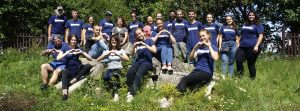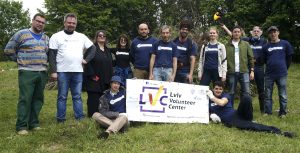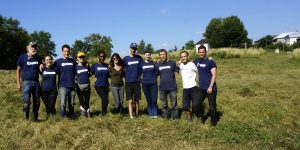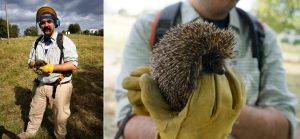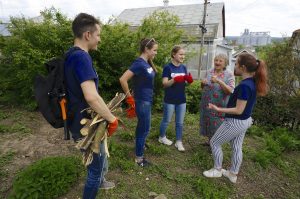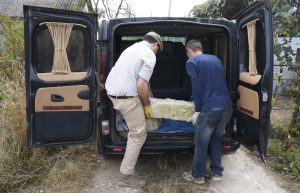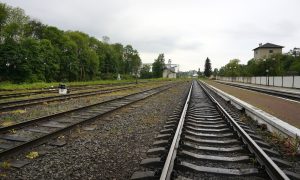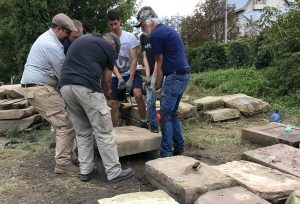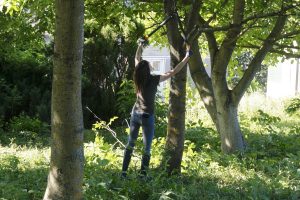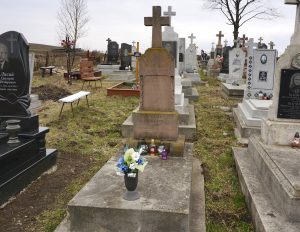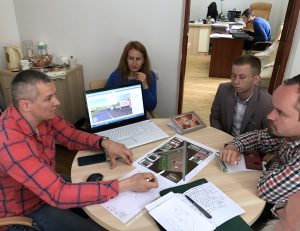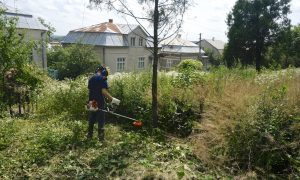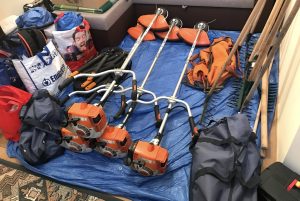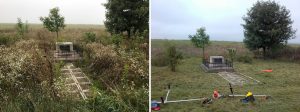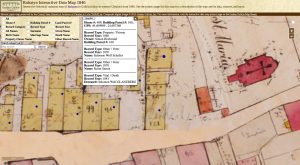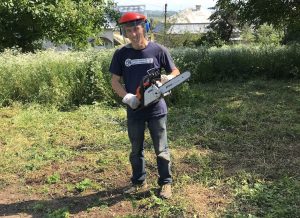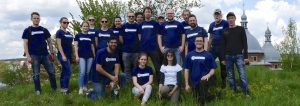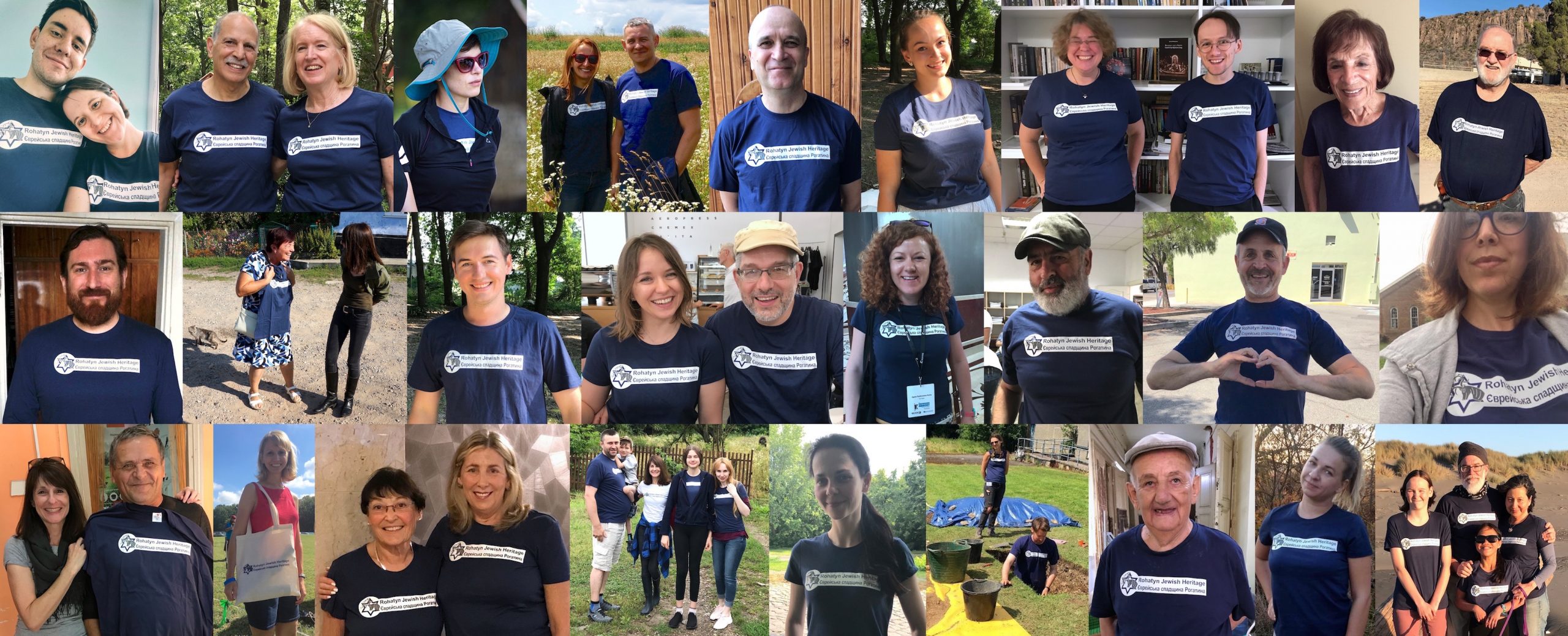This is a descriptive annual report for Rohatyn Jewish Heritage (RJH) covering the calendar year 2019 – in essence a year-in-review summary of our project progress and events, with an outline of our finances as well. To compare our progress in 2019 to our forecast of a year ago, see also our report for 2018. Most elements of this review are hyperlinked to pages with more information, on or off of our website.
![]() Ця сторінка також доступна українською.
Ця сторінка також доступна українською.
VOLUNTEERS AND PARTNERS
Our work always depends heavily on a small number of institutional partners and a large number of active volunteers. Many of the people and organizations who contributed to our work this year have helped us in prior years, but we were also very happy to welcome new faces, hands, and hearts.
Most of our partnerships are informal, connected by the volunteer spirit of the good people we meet from western Ukraine and all over the world. Here very briefly are several groups who were active with us this year (you see them mentioned throughout our project updates below), with whom we hope to continue on their projects and ours for years to come: the Lviv Volunteer Center (LVC); the Sholem Aleichem Jewish Cultural Center; Peace Corps Volunteers in Ukraine; Law Craft Legal Services and Consulting; the City of Rohatyn and the Rohatyn Opillya Museum; Fulbright Ukraine; the Staffordshire University Centre of Archaeology; Rohatyn District Research Group (RDRG); Gesher Galicia; and the Center for Urban History of East Central Europe.
Among the many individuals who helped us this year, we especially want to acknowledge our good friend Vasyl Yuzyshyn, the many remarkable Peace Corps Volunteers who joined us in heavy work, plus our translators, our frequent heritage travel companions and friends (journalists, historians, bloggers, and photographers), the numerous Fulbright scholars and students who met with us to exchange experiences and ideas, and the many friendly citizens of modern Rohatyn who help keep us connected to news and events in town. It has been especially gratifying this year to work alongside several Ukrainian natives of Rohatyn, including Rohatyn students, in Rohatyn’s Jewish cemeteries during our volunteer events.
We continue to build on the advice and support of partners from past years, especially The Matzevah Foundation (TMF), and we are forever grateful for the help they and others have provided.
PROJECTS
Our primary effort in 2019, which is reflected both in the number of news articles and in its portion of our overall expenses, was clearing wild vegetation and conditioning the grounds of Rohatyn’s four Jewish burial sites (two prewar cemeteries and two wartime mass graves). Expanding our learning from 2018, we organized and conducted four major multi-day volunteer events (in May, July, August, and September) and several one-day specialized efforts with just Marla, Vasyl, and me. Most of the work focused on the large and complex old cemetery, but every site was cleared at least once during the year.
Overall we spent 42 days at the sites in Rohatyn working with more than 50 volunteers from Rohatyn and from all over the world, several of whom worked with us repeatedly this year; we invite you to browse the photos in the news articles linked above to appreciate their diversity and enthusiasm. In addition to clearing new wild growth (in some cases three times), we also cut back larger shrubs and thickets from every corner of both cemeteries for the first time, which will help ongoing maintenance in future years so long as we stay vigilant and active. This year we added two motorized saws (a chainsaw and a reciprocating saw) to our tool set to begin surgical cutting of old shrub and tree stumps at the cemeteries, a long-term task which may require that we purchase additional saws next year to make greater progress.
Marla and I would like to highlight the power and volunteer spirit of the many Peace Corps Volunteers (PCVs) who not only gave their time and muscles to our project, but helped us in many other ways by managing their own travel and accommodations, engaging with cemetery neighbors and townspeople, working out cutting strategies at the cemetery sites, and answering every challenge with a solution and a smile. We would particularly like to thank Rohatyn’s own Peace Corps Volunteer Andrés Rodriguez, who repeatedly served as the local hub for all PCVs at each major event this past year, coordinating and communicating locally and at a distance to arrange transport, beds, meals, and more; his was a major contribution to the success of our work.
Besides the major clearing events this year, we also organized some special clearing at the north mass grave site to enable a new ground-penetrating radar survey by the same team of archaeologists who had performed the original survey in 2017, the Centre of Archaeology at Staffordshire University. This supplemental work extended the survey data into an area identified by a Rohatyn resident in 2018 as a known grave site based on work there some decades past. The new survey work was donated to Rohatyn Jewish Heritage as a sponsored charity project by the Centre; a report on the results of the research will be published in 2020.
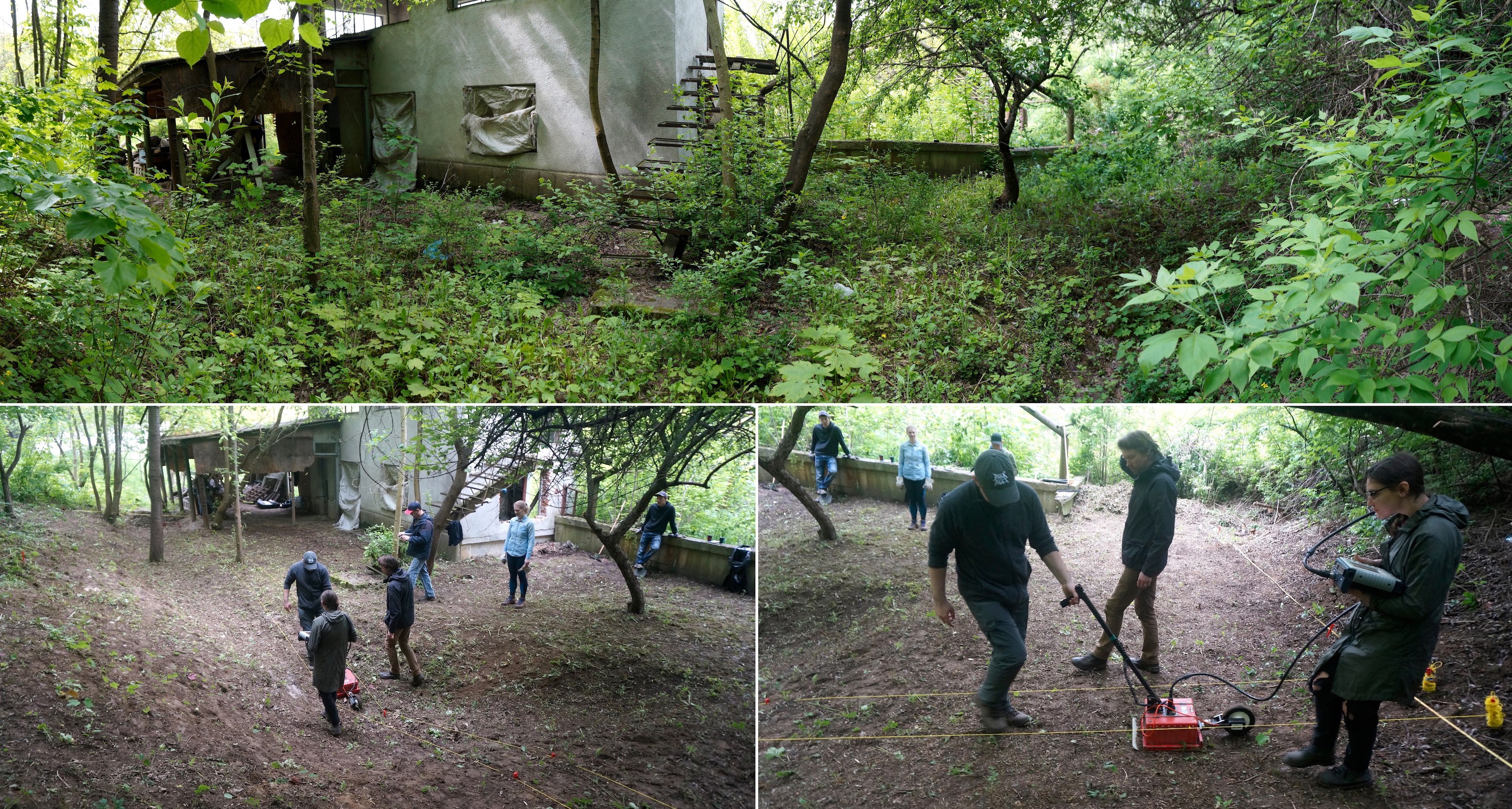
The north mass grave site before clearing (top) and after clearing, during the survey (bottom), Photos © 2019 RJH.
Other project work this year continues past efforts of different types. With friends we recovered Jewish headstones from two sites in Rohatyn and returned them to the old cemetery; we were also pleased to see that local people twice anonymously brought headstones to the cemeteries themselves from unknown locations, a sign that citizens recognize that the cemetery is being cared for and is a safe place to bring the stones.
We also hired a groundskeeper in Rohatyn this year to continue maintaining the area around the two mass grave memorials by cutting grass, planting flowers, and monitoring the sites for cleanliness; our long-time friend Mykhailo Vorobets is now too elderly to care for the sites as a volunteer and helped us to make the arrangements with the new groundskeeper. Despite his age, Mr. Vorobets was able to join us at one of the two small memorial events we held at the mass grave sites this year, commemorating 77 years of the March 1942 aktion, and 76 years of the June 1943 aktion.
Another continuing project in 2019 was the development of our project website. New articles added this year included expanded pages on the Jewish physical heritage in Rohatyn, with new material on the train station in town and the wartime rail transports of Jews to the death camp near Bełżec. This year also saw the publication of a second edition of ghetto survivor Donia Gold Shwarzstein’s “Remembering Rohatyn and Its Environs”, for which we wrote a new summary webpage. We would like to thank our friends and translators Svitlana Bregman and Nataliya Kurishko for keeping our website bilingual and for their gentle advice about nuanced issues of language.
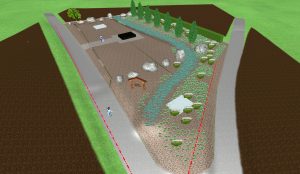
A bird’s-eye view of the northwestern approach to the memorial site, as designed. Image © 2019 Green Garden.
This year we also saw the completion of a first full plan for a new landscaping design for the south mass grave memorial site, which we had just begun working on in late 2018. The Lviv-based landscape architecture firm Green Garden LLC with whom we had contracted arranged a site survey and then developed a design proposal incorporating new ground cover, signage, and visual elements from our and their initial ideas. Together we reviewed the concepts with Rabbi Kolesnyk of Ivano-Frankivsk and the land resources department head for the City of Rohatyn. Then Green Garden assembled a detailed design with itemized ground preparation, materials, plants, benches, and other elements, and submitted the design to us to complete this phase of the project; their report is now online for public review. We will be reviewing the design for opportunities to reduce estimated costs before we proceed with revisions and possible future implementation.
As in past years, our project work in 2019 included joint efforts with partners at sites beyond Rohatyn. We were especially pleased to join several days of another well-organized international volunteer work camp led by the Lviv Volunteer Center (LVC) to clear debris at the Jakob Glanzer synagogue in Lviv, to clear vegetation and garbage from within and around the ruined synagogue in Sokal, and to organize and clean broken headstones at the new Jewish cemetery in Lviv (we had helped to recover the stones last year from under Barvinok Street in the city). We also joined a one-day volunteer event the LVC conducted to clear trees and heavy shrubs around the Jewish mass grave memorial north of Rudky in the Lviv oblast. We are always happy to lend hands and tools to the LVC, who have helped us in Rohatyn many times in past years; it is this cooperation between small volunteer organizations in the region which enables all of us to make more progress than we could alone.
A NEW AND IMPORTANT PROJECT
We announced in summer of this year that Marla has been awarded a research grant from the Fulbright program to support her proposal for planning rehabilitation of the old Jewish cemetery in Rohatyn as a memorial space and shared heritage for townspeople and visitors. RJH has had a first concept and outline plan for work at the old cemetery since 2014, and since 2018 we have been working to reclaim the landscape from fast-growing wild vegetation. The new project will develop and detail designs and plans for several aspects of the concept, working with academic and professional experts in a variety of fields. The Fulbright grant does not include physical implementation of the designs, but we hope the plans will be sufficiently detailed that we can begin discussing costs and schedules for phasing portions of the designs in late 2020 or 2021.
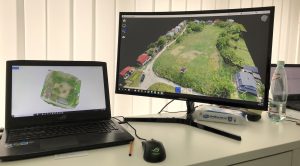
Digital models of Rohatyn’s new and old Jewish cemeteries at ESJF offices in Kyiv in September. Photo © 2019 RJH.
A key aspect of the Fulbright project will be the web publication of guidelines and reference information for others who are considering cemetery preservation projects in the region, including both local activists and foreign Jewish descendants. As the outdoor work at Rohatyn’s Jewish burial grounds began winding down in September this year, our focus turned to the Fulbright project, including research, meetings with experts, terrain survey at the old cemetery, and preliminary web development work. Completion of the new plans and the first version of the web guide is scheduled for summer next year. We hope that together the several facets of this work will help create a foundation for future projects.
VISITS AND VISITORS
As we do each year, in 2019 we made numerous trips from Lviv to Rohatyn, for project work, meetings, commemoration and city events, and to guide visitors from abroad around the Jewish heritage sites. Overall we made 23 round trips to Rohatyn, spending 42 days and 14 nights in the city, often with other working volunteers and with tools. Several of our trips included visits to villages and cemeteries in the region around Rohatyn, to research the histories of righteous Gentiles who had sheltered Jews during the wartime German occupation and Shoah. We also joined one day of a tour to Bibrka, Novi Strilyshcha, and Rohatyn organized by the Galicia Jewish Museum in Kraków and led by artist and essayist Jason Francisco; we were surprised and pleased to learn that the tour group included four Rohatyn Jewish descendants! Throughout the year, as usual we also traveled to other towns and villages in western Ukraine to study the status and evolution of Jewish heritage in those places for comparison to our own projects.
ADMINISTRATION
Rohatyn Jewish Heritage has now passed three years as a registered Ukrainian non-profit NGO, still with two employees (Marla and me) and three board members; the board includes our long-time friend and advisor Wito Nadaszkiewicz, executive director and managing partner of LawCraft Legal Services and Consulting in Lviv. In addition to maintaining the NGO’s registration, accounting, and regulatory compliance, Wito and his staff (including key attorney Bohdan Zdanevych) also interact with contractors and suppliers on our behalf, managing a significant portion of the “business” side of Rohatyn Jewish Heritage while we focus on projects and communication. This arrangement has been quite productive for us over the past three years, and we expect to continue in this mode for the foreseeable future. We credit Wito’s long-range vision for helping us chart a project path, and are deeply grateful that much of LawCraft’s work for us is provided pro bono, to permit donations we receive and our personal resources to be applied directly to project work.
FINANCE
For the past three years including 2019, we have maintained dual-track personal (US) and NGO (UA) bank accounts to stay flexible and reliable in receiving donations and covering project expenses; we also aim for transparency by publishing our income and expenses here. As always, we record and acknowledge all donations (more than 50 individual donations in 2019), and every donation (less banking and transfer fees) goes directly to project expenses. Marla and I contribute additional money from our personal savings to cover all administrative, tax, and operational costs, including our own salaries, plus some incidental project expenses. For the calendar year 2019, in US$ and using a nominal exchange rate of US$1=25UAH to allow for currency exchange and transfer fees (through 2019 the rate ranged 23.2UAH to 28.2UAH), our income and expenses were:
Jewish burial sites clearing projects 2019: US+UA bank accounts tools, parts & accessories -$ 2,392 lodging RJH+volunteers -$ 1,000 services: fuel, transport, etc -$ 1,598 meals, water RJH+volunteers -$ 1,230 --------------------------------------- total project cost 2019: -$ 6,220 individual donations via GG +$ 6,220 --------------------------------------- end balance: $ 0 (remaining tools and supplies inventory is held by RJH for use in 2020) Other NGO projects & operations: US+UA bank accounts (not including 2019 old cemetery project) start balance: +$15,203 --------------------------------------- headstone recovery tools etc -$ 64 mass graves groundskeeping -$ 300 south mass grave survey/design -$ 3,080 old cemetery landscape design -$ 782 ground transport Lviv/Rohatyn -$ 696 translations EN->UA -$ 1,132 printing, books, etc -$ 594 heritage legal research -$ 288 website domain, hosting, apps -$ 233 volunteer perks: T-shirts etc -$ 667 wire transfer fees -$ 27 --------------------------------------- net change 2019: -$ 7,863 individual donations via GG +$ 5,566 donations from other sources +$ 800 --------------------------------------- end banking balance: +$13,706 2019 unreimbursed expenses -$ 1,539 --------------------------------------- net end balance: +$12,167 [balance = +$4,795 US, +$8,911 UA, -$1,539 debt] NGO administration, salaries, etc.: UA bank account start balance: +$ 265 --------------------------------------- permit and gov't fees -$ 839 accounting fees -$ 1,200 salaries+benefits+taxes -$ 5,270 --------------------------------------- net change 2019: -$ 7,309 Osborn personal contribution +$ 7,120 --------------------------------------- end balance: +$ 76
This summary may require updating after the first of the year to include late-year donations or expenses, and a final reckoning by our accountant.
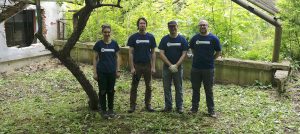
The Staffordshire team of Daria, Will, Kevin, and Alex at the north mass grave site. Photo © 2019 RJH.
Absent from this summary is the significant volunteer time donated by many friends and organizations to make many of these projects and our operations possible; we count that as a debt we hope to pay back by helping others. Also absent are expenses carried by the volunteers; for example, in addition to volunteering in cemetery clearing and conducting supplemental GPR survey work pro bono for us this year, Staffordshire University Centre of Archaeology also carried all of their own expenses for lodging, meals, and transportation during three days of site work, as well as their transport costs from the UK to Lviv. Also excluded is Marla’s Fulbright grant, which is a research stipend in lieu of salary rather than a grant for physical project work. Throughout, the list also omits personal pass-thru and side donations (e.g. books for the Rohatyn public library, etc.) made by others and by Marla and me, and ignores many small expenses which we and others chose to pay out of our pockets, for simplicity. And of course Marla and I do not count our own volunteer effort, working full-time for our NGO.
We thank Gesher Galicia, and in particular their membership chair Shelley Kellerman Pollero and former CFO/treasurer Ann Gleich Harris, for making the donations process to Rohatyn Jewish Heritage tax-deductible for US taxpayers, and simple for everyone.
LOOKING TO 2020
Now with nine years of experience and three years of full-time work, we are learning to adapt to issues and opportunities, and to prioritize and pace ourselves for both time and expenses. Some projects we had hoped to complete in 2019 will carry forward to 2020, partly to give partners a chance to complete their portions of the work, and partly so we could advance projects we had not expected to start in 2019.
Next year will of course include several cemetery clearing events, hopefully with a variety of volunteers as in the past. We anticipate that the balance of tools and techniques will shift some from 2018 and 2019, now that much of the heaviest vegetation has been cut to near the ground. Stump cutting will become a larger task for us, and a larger portion of the clearing work will involve the motor tools as opposed to hand tools. But fast re-growth of grasses and young trees will challenge every tool we have, as always.
Marla’s Fulbright project will continue in 2020 and complete in summer, bringing forward the development of rehabilitation plans for the old Jewish cemetery, and engaging new tools and experts as we begin considering a memorial space for the recovered headstones, signage, and more.
We progressed landscape plans for the south mass grave as planned in 2019, but stopped short of implementation because of estimated costs. In 2020, we will review those plans with other local experts, consider alternative approaches we have seen in Ukraine, and attempt to develop a practical design which retains our original objectives of improving protection of the grounds, enhancing its appearance, providing informational signage, and reducing the need for ongoing landscape maintenance, but which can be managed with limited funding. At a minimum, we will put a priority on maintaining the grounds around the memorial monuments at both mass grave sites, and on clearing heavy brush over the entire grave area at the south site.
After completing a first version of the cemetery preservation guide for Marla’s Fulbright project, we will continue our RJH website work with additional Jewish heritage topic pages, and begin considering local tourism maps and tools. We still have a few survivor memoirs and other testimonies to summarize for our site, including two currently in progress. Publication of Jack Glotzer’s memoir “I Survived the German Holocaust Against All Odds” in bilingual book format did not happen in 2019 as we had hoped; we are waiting for an important essay by a scholar of personal memoirs and oral history for inclusion in the book, and we hope to have that in time for web and print publication in 2020.
We have completed technical development with Gesher Galicia of an interactive historical map of Rohatyn which features family history data pinned to locations in the town. That map functions online on my private server and is waiting for some further website development work at Gesher Galicia before it can go public, probably in 2020.
We expect the unexpected again in 2020 as well: more headstone recoveries, opportunities for joint heritage preservation projects with our partners, Jewish history and heritage book events in Lviv and Rohatyn, other mapping projects, and other activities which are not currently forecast.
THANK YOU TO OUR SUPPORTERS
As has been true for all of the three past years, our dear friend Vasyl Yuzyshyn worked hand in hand as a volunteer with us every day of our major and minor project work, giving his time and energy freely no matter the task, including vegetation clearing and tool maintenance, interpreting discussions between Ukrainian and English speakers, making arrangements with suppliers and service providers, and helping to keep our spirits up with his good cheer. Vasyl has been a pillar of strength whose friendship we treasure as much as his many contributions.
It is evident throughout this report: Rohatyn Jewish Heritage thrives on the support of interested and engaged friends near and far, which in 2019 included more than a hundred donors and volunteers. As always, Marla and I want to thank everyone who led, supported, encouraged, funded, reported, corrected, translated, and shared our work in 2019, which enabled and amplified our efforts well beyond anything we could have done ourselves. We are grateful for the time, ideas, connections, donations, labor, humor, and love we received in this work, which has been inspiring again and again. Our website news articles from 2019 show nearly all of the volunteers who worked with us in Rohatyn, and you’ll see some of the many other people who cheered our every day this past year in the RJH-logo t-shirt collage below. We are very much looking forward to 2020, with new challenges and accomplishments, and a stronger presence for the Jewish heritage in Rohatyn.

